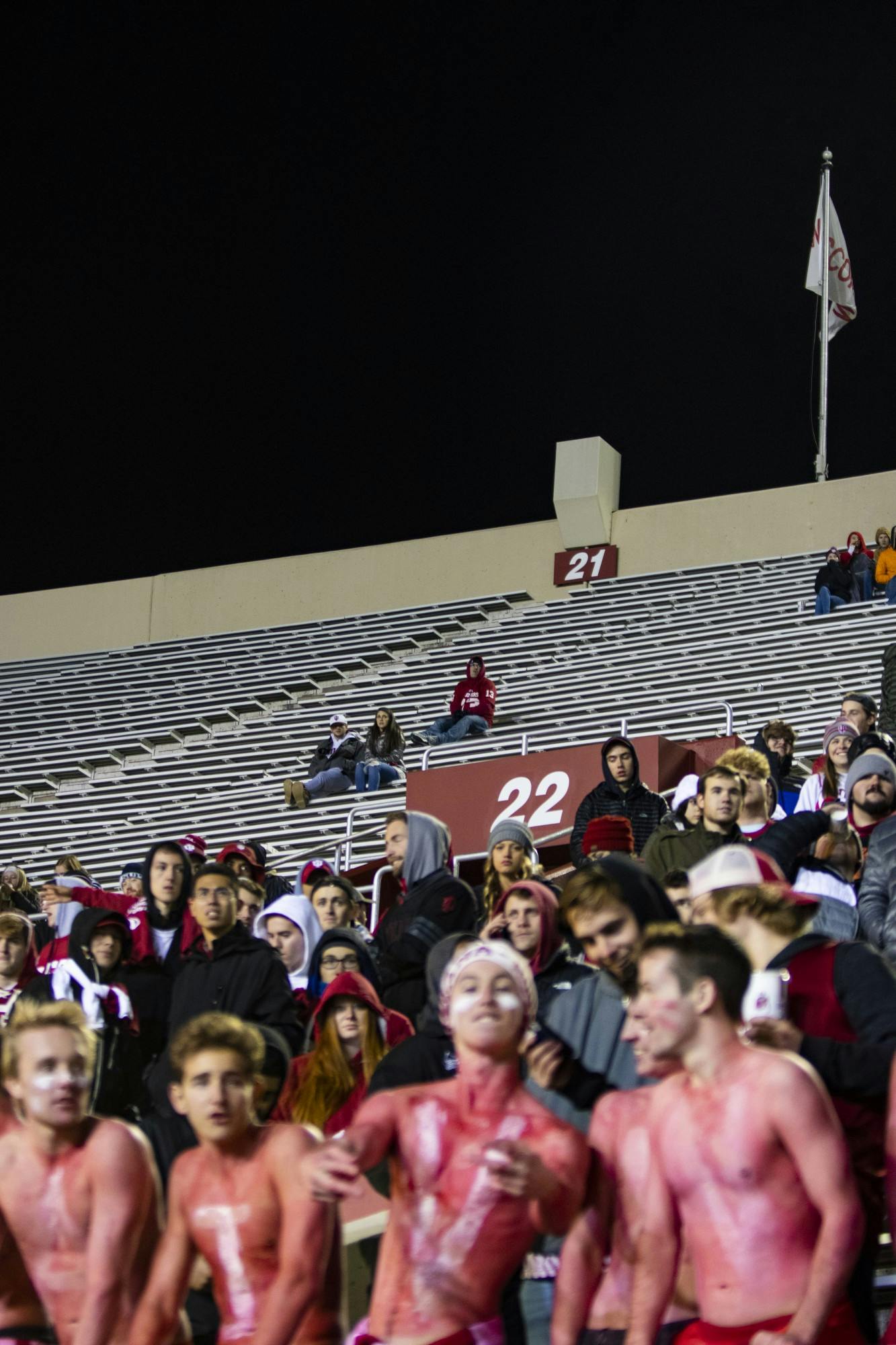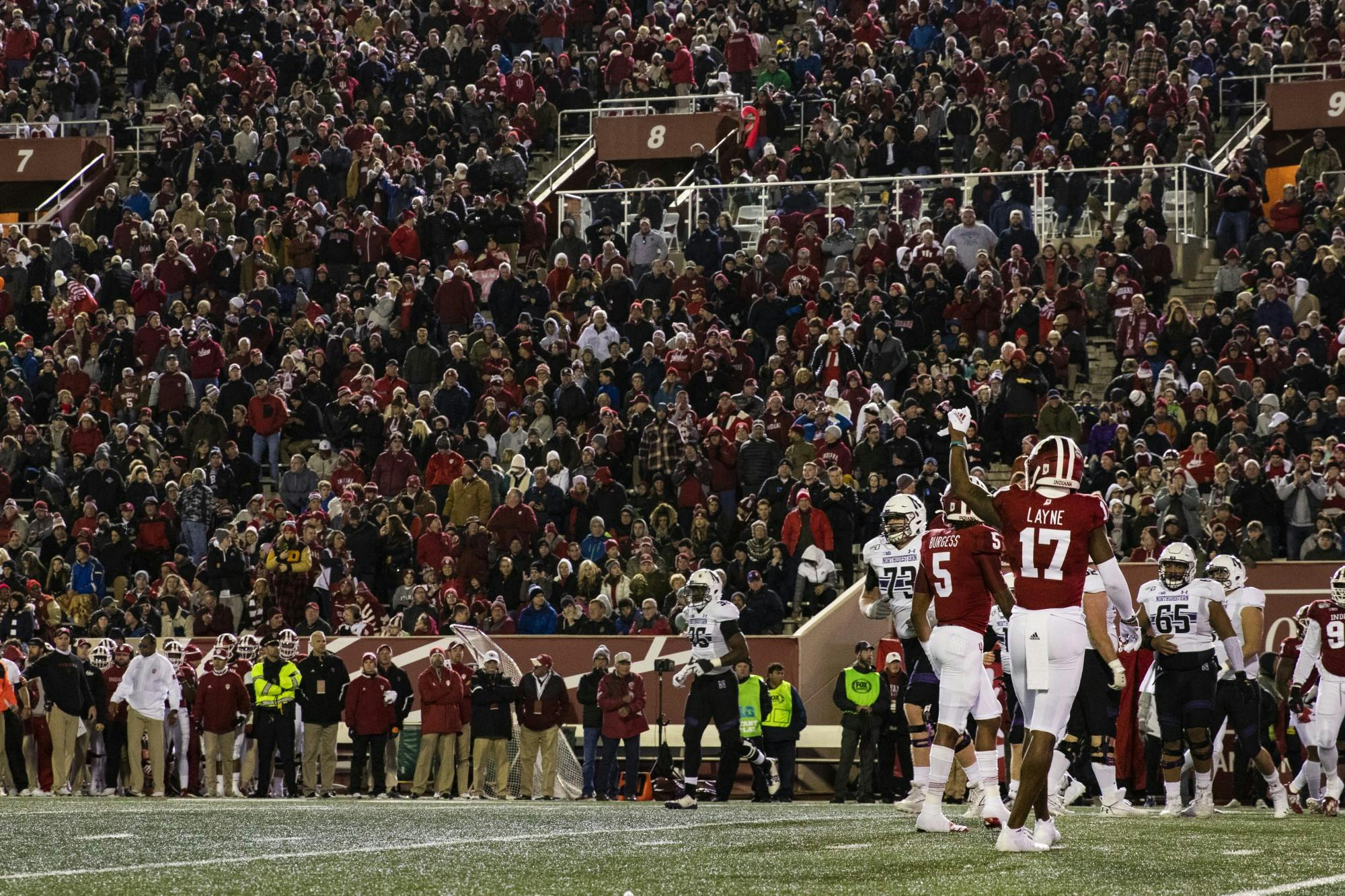IU’s attendance for two major sports, men’s basketball and football, has declined in the last decade.
The Indiana Daily Student analyzed attendance figures IU reported to the NCAA for football and men’s basketball, the school’s two highest-attended sports, since 2010. Although attendance was creeping upward from 2010-12, IU’s football attendance has dropped 7.4% since its peak during the 2012-13 football season. Men’s basketball attendance has declined 11.4% in the same timeframe.
The analysis took the season total for attendance in football and basketball divided by the amount of games in that season and stadium capacities to calculate how full a stadium was as a percentage during that season on average.
For example, 280,631 people attended IU men’s basketball games during the 2018-19 season. That figure, divided by the 18 home games IU played that season, shows the average attendance for a game was 15,591. That divided by Simon Skjodt Assembly Hall’s capacity of 17,222 means the stadium was, on average, 90.5% full for a home men’s basketball game that season.
This attendance is close to average for the entire Big Ten conference. The IDS also analyzed the NCAA football attendance records for all Big Ten schools since 2010. Football attendance across the conference has declined 3.3% since the 2014 season, when the conference averaged 90.3% attendance at home football games.
A 3.3% decline may not seem significant, but lower attendance brings less money to the communities surrounding schools. This decline happened after the Big Ten added Maryland and Rutgers to the conference for the 2014-15 season.
The analysis also accounted for changes in capacity in Big Ten football stadiums and in Simon Skjodt Assembly Hall. For example, Memorial Stadium’s construction on the south side of the stadium, completed in 2018, reduced the capacity from 52,929 to its current 52,626.
An IU Athletics spokesperson declined to comment for this story.
IU football struggles to fill Memorial Stadium
In the 2019-20 season, in which IU had its best record since 1993-94 and earned a spot at the TaxSlayer Gator Bowl, Memorial Stadium was 78.4% full on average. A bowl game is a post-season college football game that belongs to the NCAA’s Division I Football Bowl Subdivision.
The team went 8-5 and earned a winning record in Big Ten conference play for the first time in 26 years. Yet it was the third worst season for football attendance in the decade.
IU's worst attendance of the 2010s came in the 2018-19 season. Only 77.8% of Memorial Stadium was full on average.
Five IU football seasons in the 2010s averaged less than 80% capacity per game. Two of those seasons, 2014 and 2019, ended with bowl game appearances, something IU has only accomplished 12 times since the football team was founded in 1887.
These attendance figures only track the fans entering the stadium. However, many fans tend to leave after the first half of the game.
Raekwon Jones, an IU linebacker from 2015-19, experienced that from the field.
“At first, it was frustrating to see, but eventually we realized we were going to just play for each other and the true fans who stuck it out,” Jones said.
Tegray Scales, an IU linebacker from 2014-2017, now plays for the Dallas Renegades XFL football team.

“People want a winning environment and want to cheer for a team that wins,” Scales said. “But it was tough when we were in close games and we came out in the second half, seeing more than half of the fans had left.”
The 2019 season also included home games against Big Ten East division rivals Ohio State and Michigan that were expected to attract larger crowds, given the hype around games against rivals.
When Ohio State played in Bloomington for the first game of the 2017 season, Memorial Stadium was at capacity. But when they returned for the Big Ten opener in 2019, the second home game of the season, attendance dropped by 9% compared to the 2017 game.
The next highest mark in the 2019 season was on a freezing, wet senior day against No. 13 Michigan. Only 83% of the stadium was full. Memorial Stadium was at full capacity for the previous Michigan game in 2017.
Notably, two of the three worst-attended football seasons in the decade, 2018-19 and 2019-20, came after IU made back-to-back bowl games in 2015 and 2016 and finished one game shy of bowl eligibility in 2017, one of the most successful stretches in IU football history.
IU basketball attendance has dropped more than 10% since 2013
IU men’s basketball attendance has also dropped since its peak in the early 2010s.
The 2008-2011 IU men's basketball teams had some of the worst winning percentages in IU history, in part due to sanctions from an NCAA recruiting scandal. The 2012-13 season was a return to competitiveness for the men's basketball program.
In the 2012-13 season, the team won a Big Ten regular season championship and earned a No. 1 seed in the NCAA Tournament.
That year, IU reported nearly full capacity during the season, with games averaging 99.7% attendance at Simon Skjodt Assembly Hall.
In the 2018-19 season, attendance dropped to 88.3% on average, an 11.4% drop over five seasons.
Between the 2012-13 and 2018-19 seasons, IU made two NCAA tournaments and earned one appearance in the National Invitational Tournament. IU played three extra home games in the 2018-19 season by virtue of being a No. 1 seed in the NIT, giving fans a chance to see IU play in three postseason tournament games at home.
It wasn’t enough to stop the trend of declining attendance.
IU’s football and men’s basketball ticket sales nearly mirror each other
When comparing season average attendance figures for IU football and men’s basketball, the numbers appear to rise and fall based on each other's performance.
Correction: A previous version of this graphic did not specify the time frame in which IU men's basketball attendance dropped. The IDS regrets this error.
A successful IU men’s basketball season appears to lead to higher attendance for football games in the fall. In spring 2012, an NCAA Tournament for men’s basketball coincided with a 8.3% increase in football attendance in the fall.
When the men’s basketball team didn’t make a postseason tournament in 2014, football attendance dropped by 6% the next season.
In 2017-18, football attendance didn’t trend with men’s basketball. After men’s basketball attendance declined by 2.9% from 2015-17, IU football attendance inched higher in the 2017-18 season, going from 81.3% to 83% following back-to-back bowl game appearances.
In the 2017-18 football season, the team missed a bowl game by one win. Football attendance dropped 6.3% in the following 2018-19 season.
Ticket sales affect IU Athletics' bottom line
While declining attendance figures can weigh on a player’s mind and create optics problems, they can also affect the athletic department’s annual budget.
Men’s basketball and football ticket sales, the two sports drawing more fans than any other sports, account for only just under 15% of IU Athletics’ annual budget, drawing in just over $16 million.
The primary source of athletics income at IU comes from the Big Ten’s media package, which determines which TV channels its sports are broadcast on.
This TV/Radio category brought in over $42.5 million to the athletics department in 2018-19. That’s just over 38% of the income IU Athletics received, and the largest category.
One of the effects of not selling out football games in particular is a need for more fundraising to compensate for lost revenue, something outgoing athletic director Fred Glass mentioned in a press conference in December.
“Because we have a small football stadium that we don’t fill, we’re at a huge economic disadvantage with those that we compete against,” Glass said.
Fundraising is the second-largest source of athletics income. The department has brought in over $215 million through its Bicentennial Campaign for IU Athletics, which launched in 2016. The fundraising was primarily through multi-million dollar donations from alumni. More than $24 million raised in 2018-19, labeled under “Varsity Club Gifts,” was 21% of the total income.
Glass said the $6.5 million IU Athletics makes in football ticket sales is the least amount of revenue generated in the Big Ten. He added that half of the conference brings in $20 million or more in revenue.
“That matters when hiring coaches and investing in things,” Glass said. “So that’s part of the reason we’ve been so aggressive in fundraising a little bit, to get those extra dollars.”





